Financial Reporting: AASB and Differential Reporting Analysis
VerifiedAdded on 2020/02/24
|8
|1629
|35
Report
AI Summary
This report provides an analysis of financial reporting practices within Australia, focusing on the Australian Accounting Standards Board (AASB) and its impact on differential reporting. It discusses the evolution of differential reporting, the shift towards a reporting entity model, and the introduction of tiered standards (Tier 1 and Tier 2) for general-purpose financial statements. The report examines the requirements for different entities, including those adhering to International Financial Reporting Standards (IFRS) and those utilizing reduced disclosure requirements. It highlights the AASB's efforts to balance disclosure needs with user requirements, particularly through Exposure Draft 277, and explores the implications of these changes for directors, committee members, and the overall financial reporting landscape. The report concludes by emphasizing the responsibilities of stakeholders to ensure financial reporting meets user demands and provides opportunities for education and adaptation to new standards.
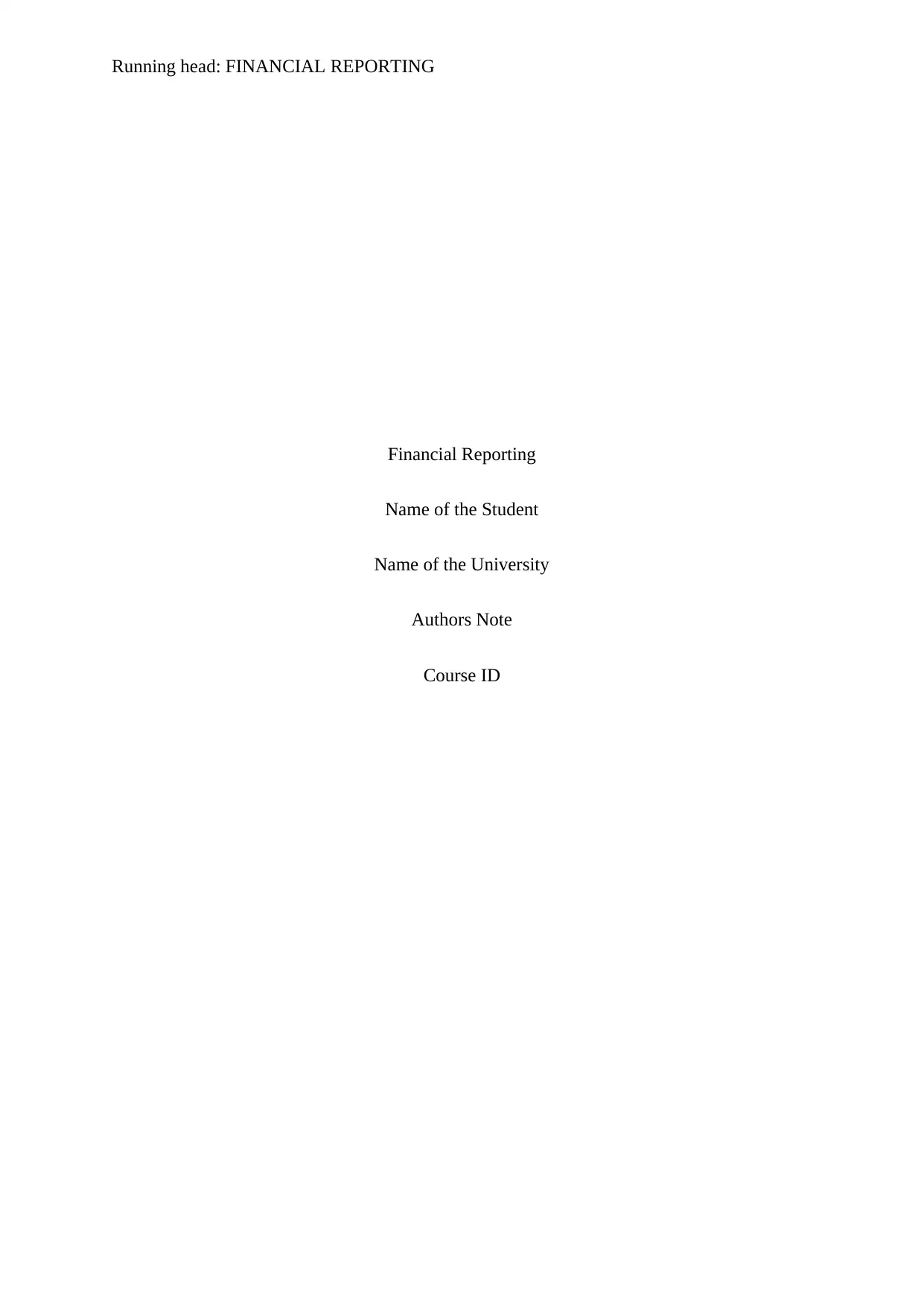
Running head: FINANCIAL REPORTING
Financial Reporting
Name of the Student
Name of the University
Authors Note
Course ID
Financial Reporting
Name of the Student
Name of the University
Authors Note
Course ID
Paraphrase This Document
Need a fresh take? Get an instant paraphrase of this document with our AI Paraphraser
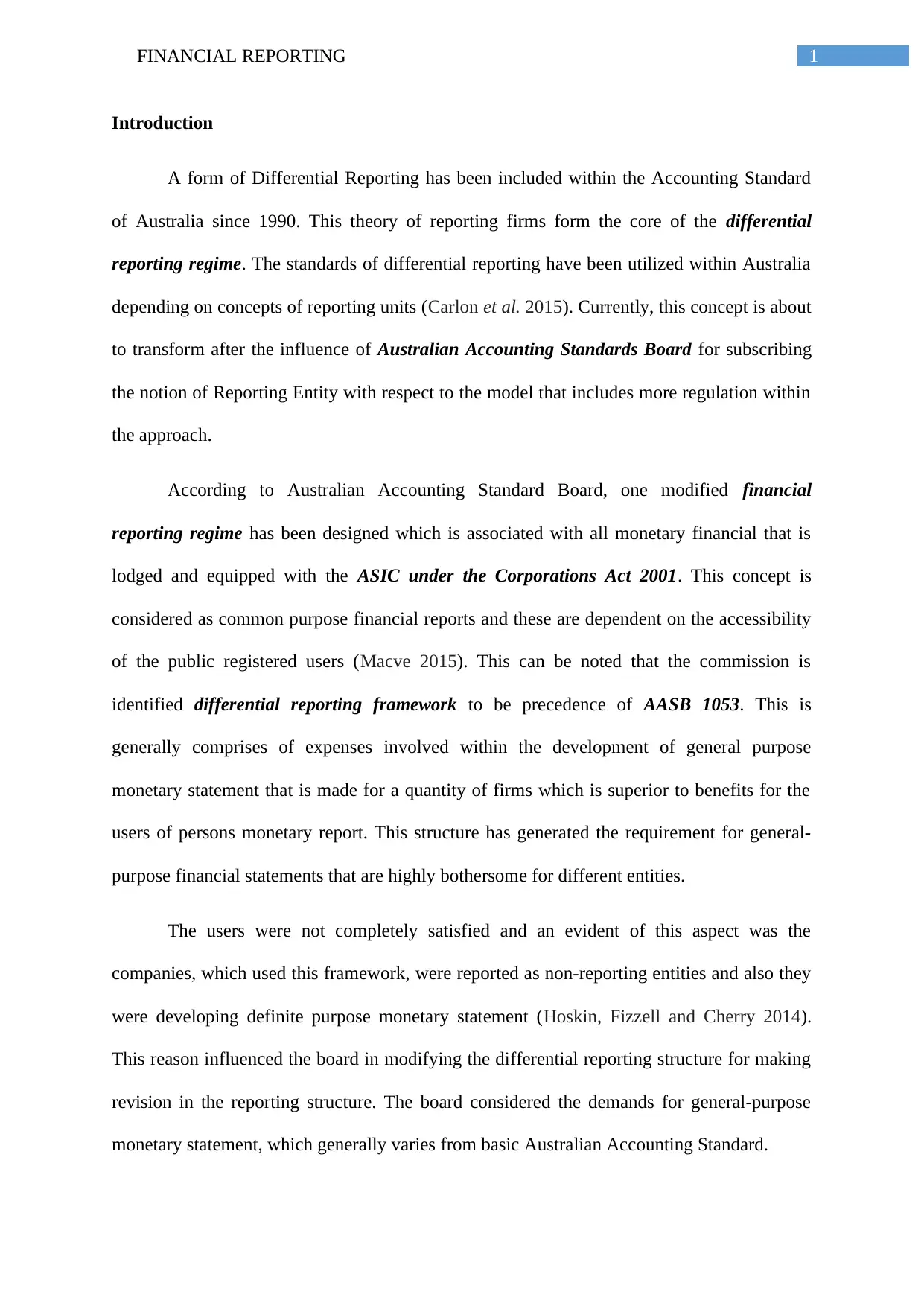
1FINANCIAL REPORTING
Introduction
A form of Differential Reporting has been included within the Accounting Standard
of Australia since 1990. This theory of reporting firms form the core of the differential
reporting regime. The standards of differential reporting have been utilized within Australia
depending on concepts of reporting units (Carlon et al. 2015). Currently, this concept is about
to transform after the influence of Australian Accounting Standards Board for subscribing
the notion of Reporting Entity with respect to the model that includes more regulation within
the approach.
According to Australian Accounting Standard Board, one modified financial
reporting regime has been designed which is associated with all monetary financial that is
lodged and equipped with the ASIC under the Corporations Act 2001. This concept is
considered as common purpose financial reports and these are dependent on the accessibility
of the public registered users (Macve 2015). This can be noted that the commission is
identified differential reporting framework to be precedence of AASB 1053. This is
generally comprises of expenses involved within the development of general purpose
monetary statement that is made for a quantity of firms which is superior to benefits for the
users of persons monetary report. This structure has generated the requirement for general-
purpose financial statements that are highly bothersome for different entities.
The users were not completely satisfied and an evident of this aspect was the
companies, which used this framework, were reported as non-reporting entities and also they
were developing definite purpose monetary statement (Hoskin, Fizzell and Cherry 2014).
This reason influenced the board in modifying the differential reporting structure for making
revision in the reporting structure. The board considered the demands for general-purpose
monetary statement, which generally varies from basic Australian Accounting Standard.
Introduction
A form of Differential Reporting has been included within the Accounting Standard
of Australia since 1990. This theory of reporting firms form the core of the differential
reporting regime. The standards of differential reporting have been utilized within Australia
depending on concepts of reporting units (Carlon et al. 2015). Currently, this concept is about
to transform after the influence of Australian Accounting Standards Board for subscribing
the notion of Reporting Entity with respect to the model that includes more regulation within
the approach.
According to Australian Accounting Standard Board, one modified financial
reporting regime has been designed which is associated with all monetary financial that is
lodged and equipped with the ASIC under the Corporations Act 2001. This concept is
considered as common purpose financial reports and these are dependent on the accessibility
of the public registered users (Macve 2015). This can be noted that the commission is
identified differential reporting framework to be precedence of AASB 1053. This is
generally comprises of expenses involved within the development of general purpose
monetary statement that is made for a quantity of firms which is superior to benefits for the
users of persons monetary report. This structure has generated the requirement for general-
purpose financial statements that are highly bothersome for different entities.
The users were not completely satisfied and an evident of this aspect was the
companies, which used this framework, were reported as non-reporting entities and also they
were developing definite purpose monetary statement (Hoskin, Fizzell and Cherry 2014).
This reason influenced the board in modifying the differential reporting structure for making
revision in the reporting structure. The board considered the demands for general-purpose
monetary statement, which generally varies from basic Australian Accounting Standard.
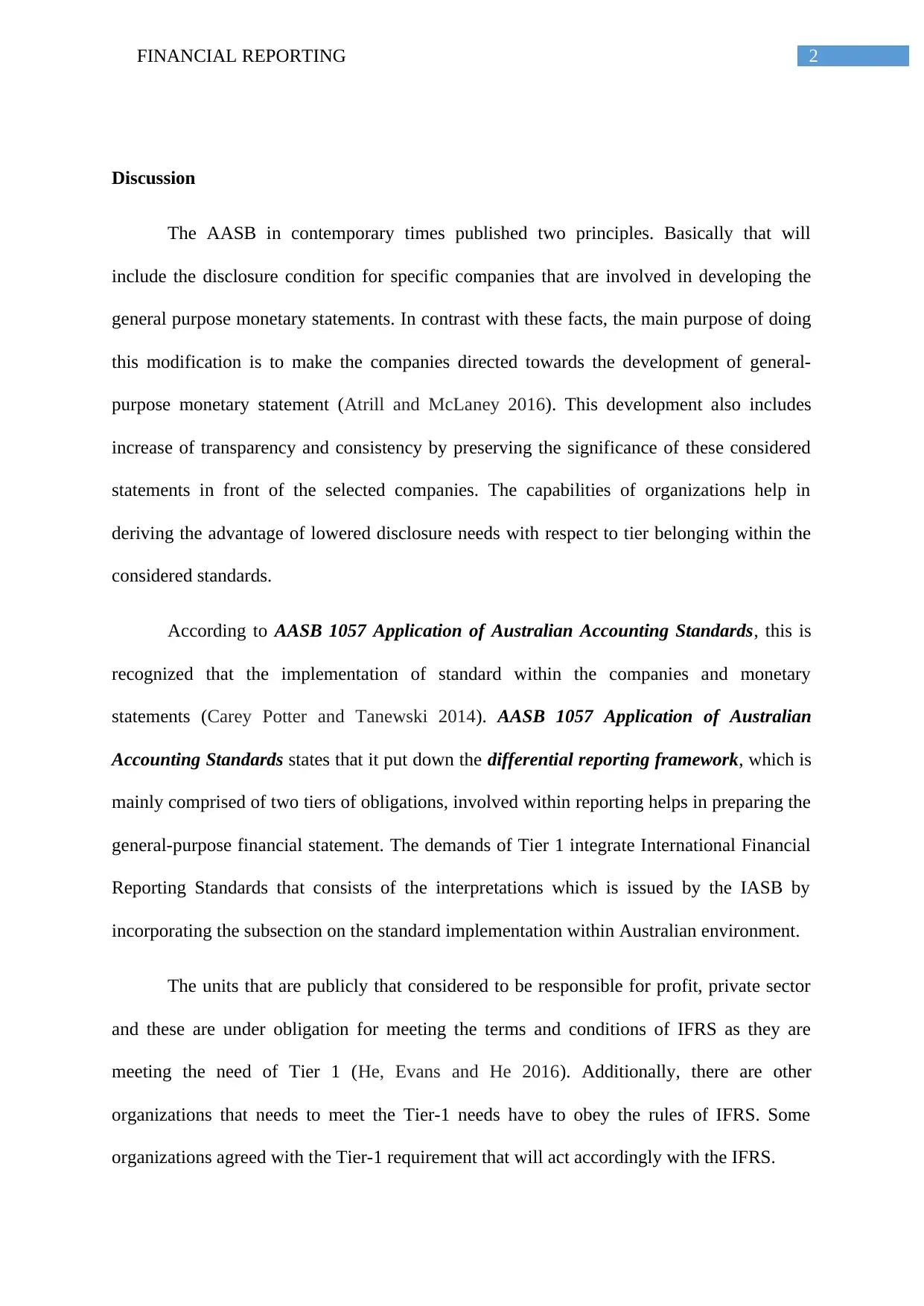
2FINANCIAL REPORTING
Discussion
The AASB in contemporary times published two principles. Basically that will
include the disclosure condition for specific companies that are involved in developing the
general purpose monetary statements. In contrast with these facts, the main purpose of doing
this modification is to make the companies directed towards the development of general-
purpose monetary statement (Atrill and McLaney 2016). This development also includes
increase of transparency and consistency by preserving the significance of these considered
statements in front of the selected companies. The capabilities of organizations help in
deriving the advantage of lowered disclosure needs with respect to tier belonging within the
considered standards.
According to AASB 1057 Application of Australian Accounting Standards, this is
recognized that the implementation of standard within the companies and monetary
statements (Carey Potter and Tanewski 2014). AASB 1057 Application of Australian
Accounting Standards states that it put down the differential reporting framework, which is
mainly comprised of two tiers of obligations, involved within reporting helps in preparing the
general-purpose financial statement. The demands of Tier 1 integrate International Financial
Reporting Standards that consists of the interpretations which is issued by the IASB by
incorporating the subsection on the standard implementation within Australian environment.
The units that are publicly that considered to be responsible for profit, private sector
and these are under obligation for meeting the terms and conditions of IFRS as they are
meeting the need of Tier 1 (He, Evans and He 2016). Additionally, there are other
organizations that needs to meet the Tier-1 needs have to obey the rules of IFRS. Some
organizations agreed with the Tier-1 requirement that will act accordingly with the IFRS.
Discussion
The AASB in contemporary times published two principles. Basically that will
include the disclosure condition for specific companies that are involved in developing the
general purpose monetary statements. In contrast with these facts, the main purpose of doing
this modification is to make the companies directed towards the development of general-
purpose monetary statement (Atrill and McLaney 2016). This development also includes
increase of transparency and consistency by preserving the significance of these considered
statements in front of the selected companies. The capabilities of organizations help in
deriving the advantage of lowered disclosure needs with respect to tier belonging within the
considered standards.
According to AASB 1057 Application of Australian Accounting Standards, this is
recognized that the implementation of standard within the companies and monetary
statements (Carey Potter and Tanewski 2014). AASB 1057 Application of Australian
Accounting Standards states that it put down the differential reporting framework, which is
mainly comprised of two tiers of obligations, involved within reporting helps in preparing the
general-purpose financial statement. The demands of Tier 1 integrate International Financial
Reporting Standards that consists of the interpretations which is issued by the IASB by
incorporating the subsection on the standard implementation within Australian environment.
The units that are publicly that considered to be responsible for profit, private sector
and these are under obligation for meeting the terms and conditions of IFRS as they are
meeting the need of Tier 1 (He, Evans and He 2016). Additionally, there are other
organizations that needs to meet the Tier-1 needs have to obey the rules of IFRS. Some
organizations agreed with the Tier-1 requirement that will act accordingly with the IFRS.
⊘ This is a preview!⊘
Do you want full access?
Subscribe today to unlock all pages.

Trusted by 1+ million students worldwide
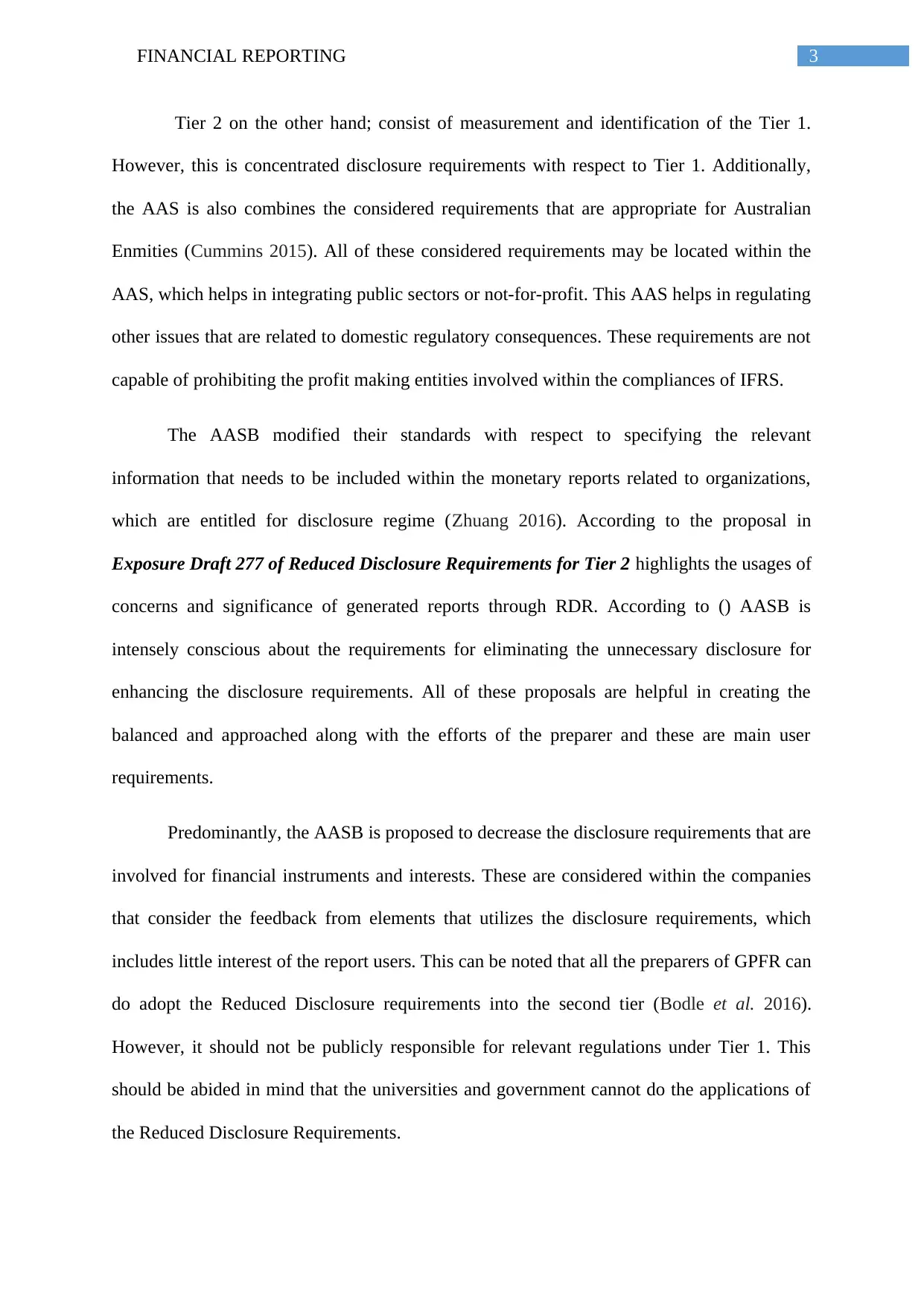
3FINANCIAL REPORTING
Tier 2 on the other hand; consist of measurement and identification of the Tier 1.
However, this is concentrated disclosure requirements with respect to Tier 1. Additionally,
the AAS is also combines the considered requirements that are appropriate for Australian
Enmities (Cummins 2015). All of these considered requirements may be located within the
AAS, which helps in integrating public sectors or not-for-profit. This AAS helps in regulating
other issues that are related to domestic regulatory consequences. These requirements are not
capable of prohibiting the profit making entities involved within the compliances of IFRS.
The AASB modified their standards with respect to specifying the relevant
information that needs to be included within the monetary reports related to organizations,
which are entitled for disclosure regime (Zhuang 2016). According to the proposal in
Exposure Draft 277 of Reduced Disclosure Requirements for Tier 2 highlights the usages of
concerns and significance of generated reports through RDR. According to () AASB is
intensely conscious about the requirements for eliminating the unnecessary disclosure for
enhancing the disclosure requirements. All of these proposals are helpful in creating the
balanced and approached along with the efforts of the preparer and these are main user
requirements.
Predominantly, the AASB is proposed to decrease the disclosure requirements that are
involved for financial instruments and interests. These are considered within the companies
that consider the feedback from elements that utilizes the disclosure requirements, which
includes little interest of the report users. This can be noted that all the preparers of GPFR can
do adopt the Reduced Disclosure requirements into the second tier (Bodle et al. 2016).
However, it should not be publicly responsible for relevant regulations under Tier 1. This
should be abided in mind that the universities and government cannot do the applications of
the Reduced Disclosure Requirements.
Tier 2 on the other hand; consist of measurement and identification of the Tier 1.
However, this is concentrated disclosure requirements with respect to Tier 1. Additionally,
the AAS is also combines the considered requirements that are appropriate for Australian
Enmities (Cummins 2015). All of these considered requirements may be located within the
AAS, which helps in integrating public sectors or not-for-profit. This AAS helps in regulating
other issues that are related to domestic regulatory consequences. These requirements are not
capable of prohibiting the profit making entities involved within the compliances of IFRS.
The AASB modified their standards with respect to specifying the relevant
information that needs to be included within the monetary reports related to organizations,
which are entitled for disclosure regime (Zhuang 2016). According to the proposal in
Exposure Draft 277 of Reduced Disclosure Requirements for Tier 2 highlights the usages of
concerns and significance of generated reports through RDR. According to () AASB is
intensely conscious about the requirements for eliminating the unnecessary disclosure for
enhancing the disclosure requirements. All of these proposals are helpful in creating the
balanced and approached along with the efforts of the preparer and these are main user
requirements.
Predominantly, the AASB is proposed to decrease the disclosure requirements that are
involved for financial instruments and interests. These are considered within the companies
that consider the feedback from elements that utilizes the disclosure requirements, which
includes little interest of the report users. This can be noted that all the preparers of GPFR can
do adopt the Reduced Disclosure requirements into the second tier (Bodle et al. 2016).
However, it should not be publicly responsible for relevant regulations under Tier 1. This
should be abided in mind that the universities and government cannot do the applications of
the Reduced Disclosure Requirements.
Paraphrase This Document
Need a fresh take? Get an instant paraphrase of this document with our AI Paraphraser
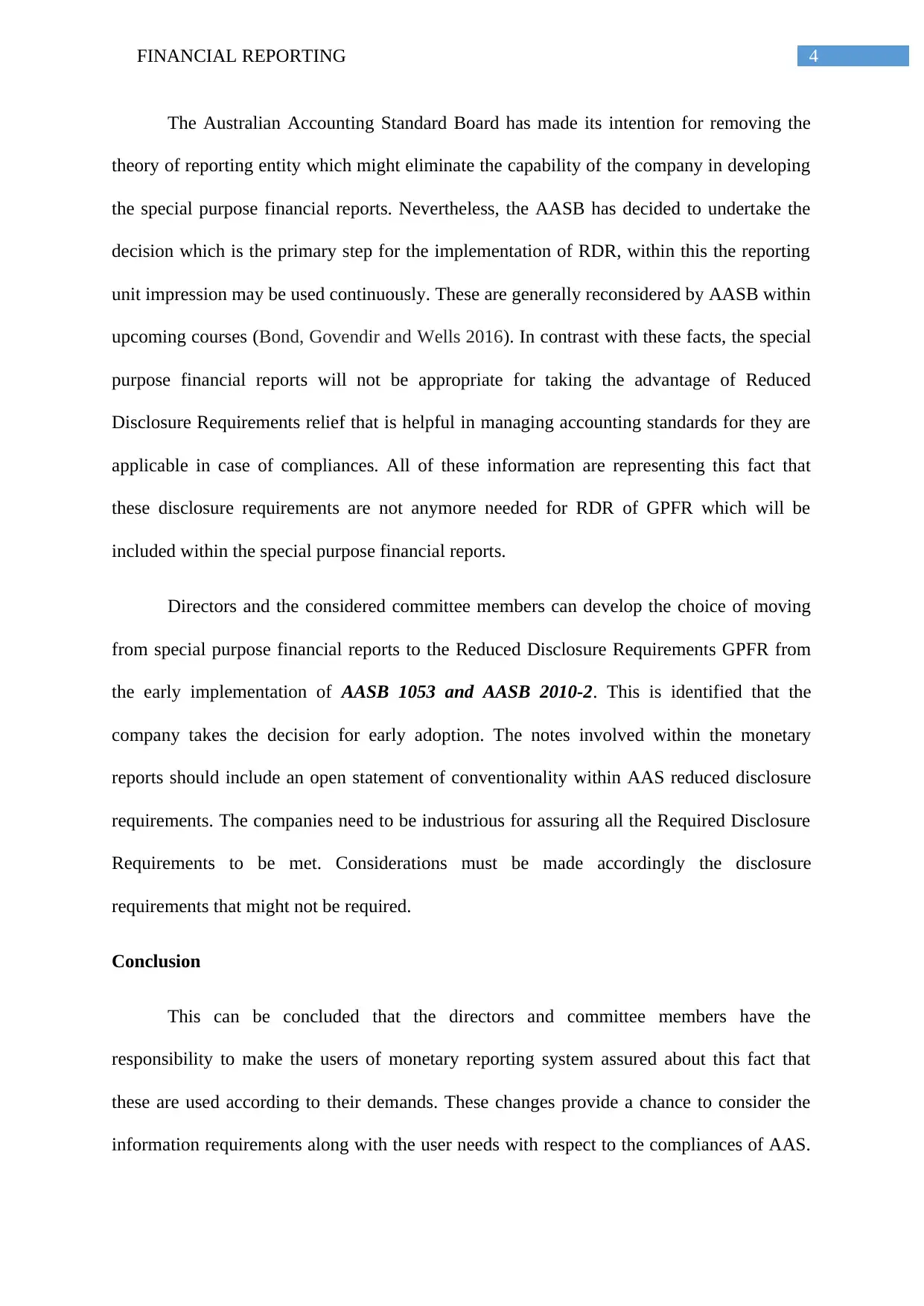
4FINANCIAL REPORTING
The Australian Accounting Standard Board has made its intention for removing the
theory of reporting entity which might eliminate the capability of the company in developing
the special purpose financial reports. Nevertheless, the AASB has decided to undertake the
decision which is the primary step for the implementation of RDR, within this the reporting
unit impression may be used continuously. These are generally reconsidered by AASB within
upcoming courses (Bond, Govendir and Wells 2016). In contrast with these facts, the special
purpose financial reports will not be appropriate for taking the advantage of Reduced
Disclosure Requirements relief that is helpful in managing accounting standards for they are
applicable in case of compliances. All of these information are representing this fact that
these disclosure requirements are not anymore needed for RDR of GPFR which will be
included within the special purpose financial reports.
Directors and the considered committee members can develop the choice of moving
from special purpose financial reports to the Reduced Disclosure Requirements GPFR from
the early implementation of AASB 1053 and AASB 2010-2. This is identified that the
company takes the decision for early adoption. The notes involved within the monetary
reports should include an open statement of conventionality within AAS reduced disclosure
requirements. The companies need to be industrious for assuring all the Required Disclosure
Requirements to be met. Considerations must be made accordingly the disclosure
requirements that might not be required.
Conclusion
This can be concluded that the directors and committee members have the
responsibility to make the users of monetary reporting system assured about this fact that
these are used according to their demands. These changes provide a chance to consider the
information requirements along with the user needs with respect to the compliances of AAS.
The Australian Accounting Standard Board has made its intention for removing the
theory of reporting entity which might eliminate the capability of the company in developing
the special purpose financial reports. Nevertheless, the AASB has decided to undertake the
decision which is the primary step for the implementation of RDR, within this the reporting
unit impression may be used continuously. These are generally reconsidered by AASB within
upcoming courses (Bond, Govendir and Wells 2016). In contrast with these facts, the special
purpose financial reports will not be appropriate for taking the advantage of Reduced
Disclosure Requirements relief that is helpful in managing accounting standards for they are
applicable in case of compliances. All of these information are representing this fact that
these disclosure requirements are not anymore needed for RDR of GPFR which will be
included within the special purpose financial reports.
Directors and the considered committee members can develop the choice of moving
from special purpose financial reports to the Reduced Disclosure Requirements GPFR from
the early implementation of AASB 1053 and AASB 2010-2. This is identified that the
company takes the decision for early adoption. The notes involved within the monetary
reports should include an open statement of conventionality within AAS reduced disclosure
requirements. The companies need to be industrious for assuring all the Required Disclosure
Requirements to be met. Considerations must be made accordingly the disclosure
requirements that might not be required.
Conclusion
This can be concluded that the directors and committee members have the
responsibility to make the users of monetary reporting system assured about this fact that
these are used according to their demands. These changes provide a chance to consider the
information requirements along with the user needs with respect to the compliances of AAS.
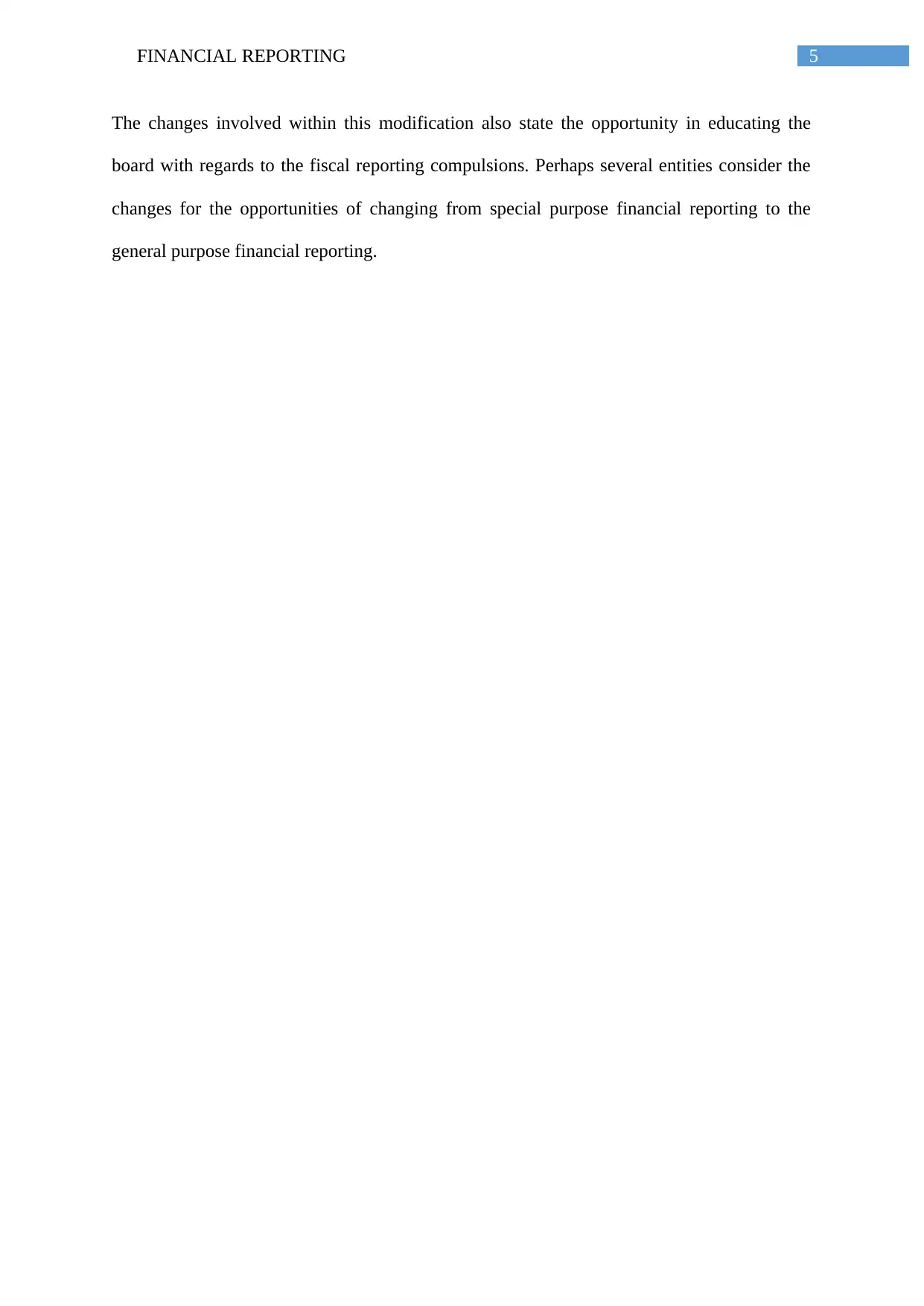
5FINANCIAL REPORTING
The changes involved within this modification also state the opportunity in educating the
board with regards to the fiscal reporting compulsions. Perhaps several entities consider the
changes for the opportunities of changing from special purpose financial reporting to the
general purpose financial reporting.
The changes involved within this modification also state the opportunity in educating the
board with regards to the fiscal reporting compulsions. Perhaps several entities consider the
changes for the opportunities of changing from special purpose financial reporting to the
general purpose financial reporting.
⊘ This is a preview!⊘
Do you want full access?
Subscribe today to unlock all pages.

Trusted by 1+ million students worldwide
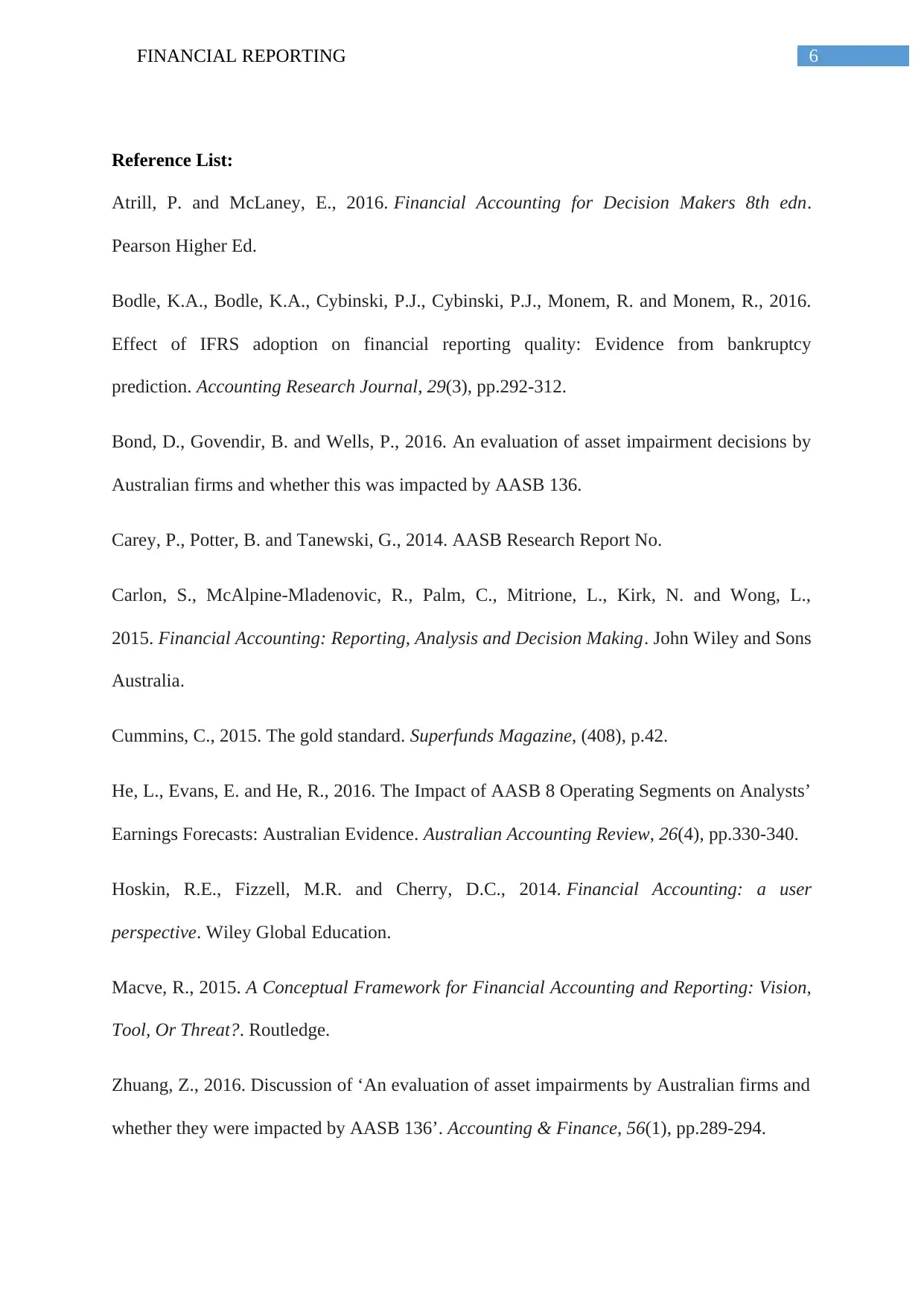
6FINANCIAL REPORTING
Reference List:
Atrill, P. and McLaney, E., 2016. Financial Accounting for Decision Makers 8th edn.
Pearson Higher Ed.
Bodle, K.A., Bodle, K.A., Cybinski, P.J., Cybinski, P.J., Monem, R. and Monem, R., 2016.
Effect of IFRS adoption on financial reporting quality: Evidence from bankruptcy
prediction. Accounting Research Journal, 29(3), pp.292-312.
Bond, D., Govendir, B. and Wells, P., 2016. An evaluation of asset impairment decisions by
Australian firms and whether this was impacted by AASB 136.
Carey, P., Potter, B. and Tanewski, G., 2014. AASB Research Report No.
Carlon, S., McAlpine-Mladenovic, R., Palm, C., Mitrione, L., Kirk, N. and Wong, L.,
2015. Financial Accounting: Reporting, Analysis and Decision Making. John Wiley and Sons
Australia.
Cummins, C., 2015. The gold standard. Superfunds Magazine, (408), p.42.
He, L., Evans, E. and He, R., 2016. The Impact of AASB 8 Operating Segments on Analysts’
Earnings Forecasts: Australian Evidence. Australian Accounting Review, 26(4), pp.330-340.
Hoskin, R.E., Fizzell, M.R. and Cherry, D.C., 2014. Financial Accounting: a user
perspective. Wiley Global Education.
Macve, R., 2015. A Conceptual Framework for Financial Accounting and Reporting: Vision,
Tool, Or Threat?. Routledge.
Zhuang, Z., 2016. Discussion of ‘An evaluation of asset impairments by Australian firms and
whether they were impacted by AASB 136’. Accounting & Finance, 56(1), pp.289-294.
Reference List:
Atrill, P. and McLaney, E., 2016. Financial Accounting for Decision Makers 8th edn.
Pearson Higher Ed.
Bodle, K.A., Bodle, K.A., Cybinski, P.J., Cybinski, P.J., Monem, R. and Monem, R., 2016.
Effect of IFRS adoption on financial reporting quality: Evidence from bankruptcy
prediction. Accounting Research Journal, 29(3), pp.292-312.
Bond, D., Govendir, B. and Wells, P., 2016. An evaluation of asset impairment decisions by
Australian firms and whether this was impacted by AASB 136.
Carey, P., Potter, B. and Tanewski, G., 2014. AASB Research Report No.
Carlon, S., McAlpine-Mladenovic, R., Palm, C., Mitrione, L., Kirk, N. and Wong, L.,
2015. Financial Accounting: Reporting, Analysis and Decision Making. John Wiley and Sons
Australia.
Cummins, C., 2015. The gold standard. Superfunds Magazine, (408), p.42.
He, L., Evans, E. and He, R., 2016. The Impact of AASB 8 Operating Segments on Analysts’
Earnings Forecasts: Australian Evidence. Australian Accounting Review, 26(4), pp.330-340.
Hoskin, R.E., Fizzell, M.R. and Cherry, D.C., 2014. Financial Accounting: a user
perspective. Wiley Global Education.
Macve, R., 2015. A Conceptual Framework for Financial Accounting and Reporting: Vision,
Tool, Or Threat?. Routledge.
Zhuang, Z., 2016. Discussion of ‘An evaluation of asset impairments by Australian firms and
whether they were impacted by AASB 136’. Accounting & Finance, 56(1), pp.289-294.
Paraphrase This Document
Need a fresh take? Get an instant paraphrase of this document with our AI Paraphraser

7FINANCIAL REPORTING
1 out of 8
Related Documents
Your All-in-One AI-Powered Toolkit for Academic Success.
+13062052269
info@desklib.com
Available 24*7 on WhatsApp / Email
![[object Object]](/_next/static/media/star-bottom.7253800d.svg)
Unlock your academic potential
Copyright © 2020–2025 A2Z Services. All Rights Reserved. Developed and managed by ZUCOL.




